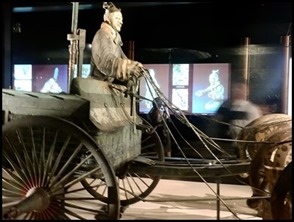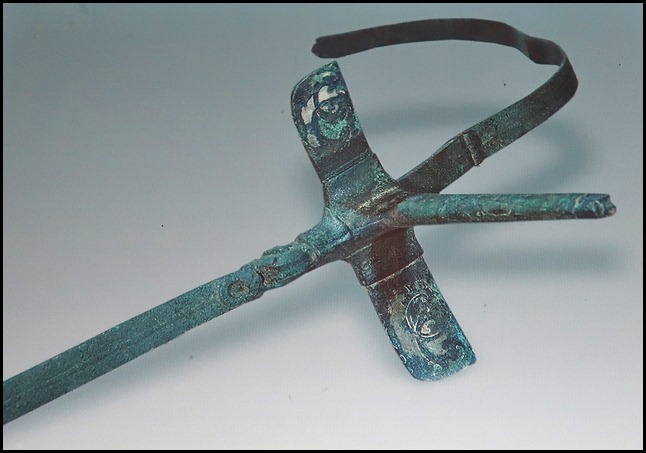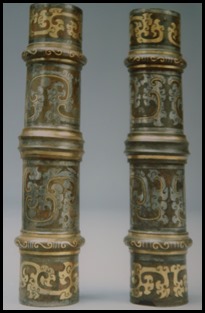TA Chariots & Horses

Beez Neez now Chy Whella
Big Bear and Pepe Millard
Tue 15 May 2018 22:27
|
The Bronze Chariots and Horses of the Emperor Qin Shi
Huang
   Our final stop at
the Terracotta Museum site was to visit the two chariots, their drivers and
horses. Through an equally impressive entrance as Pits 1, 2 and 3, we passed the
World and Chinese Heritage
symbols and down a wide
staircase.
 Before we stepped into the darkened
gallery we stopped to look at the information board. The
picture looked impressive enough. It read: The Color-Painted Bronze
Chariots and Horses in Qin Shihuang’s Tomb-yard. A huge pit of funerary chariots
and horses which takes up an area of 3025 square metres was discovered 20 metres
to the west side of Qin Shihuang’s Tomb in the summer of 1978. At the end of
1980, two big sets of color-painted chariots and horses were unearthed 7.8
metres deep underground during a partial excavation.
 The two chariots were placed
facing the west in a front and behind order in a box-like
wood outer coffin and according in their
order, they are coded as Chariot No 1 and Chariot No 2. Because the coffin was
rotten and the upper part collapsed, the chariots and horses were damaged and
many parts of the paintings scaled when they were unearthed. After eight years
of restoration, however, the bright colors and grand postures of the chariots
and horses were basically represented.
The two sets of bronze chariots
and horses were made the size of half of the practically used chariots and
horses and they are the symbol of Qin Shihuang’s chariot-horse guard of honor.
All the major parts and units of them are made of tin-bronze alloy with another
14 kg of units made of gold and silver, making up a total weight of 2302 kg. The
making of the chariots and horses is precise, vivid and complicated, the
decoration grand and the relation among the reins for different purposes clear.
The craftsmanship is fine and delicate, making them the dear objects for the
research on the ancient Chinese chariot system and
manufacture.
 Our first glance was WOW. Nothing can
prepare you for this treasure. Sad to say, a bit of a challenge - as in every
museum we visit, to get the best image without too much glare from the glass.
The detail of the horses was simply incredible. All
around the room were light boxes with information, diagrams and pictures. To
think these were buried for over two thousand years.
    The driver of
Chariot 1, detail of front right horse and
moving back to see the umbrella. No. 1 Chariot: It is the vanguard, a
two-wheeled vehicle drawn by a team of four strong horses. There is only one
seat for the driver, whose eyes are glued to the road ahead, he is sheltered
from the sun by a large umbrella. Measurement: 225 x 126 x 70
centimetres. No.
1 chariot is in the lead, with a four-horse team. It has been painted white by
conservation workers.
  Chariot 2,
loved the front right horse as he looks as if he is laughing. This chariot supposed
to serve as the vehicle for the emperor's inspection
tours in his afterlife. No. 2 Chariot: It is larger than
the No. 1. The horses are richly adorned with gold and silver gears. There are
three windows, one out front, and one on each side in the compartment, and a
door opens at the back. One may open and close the windows and the door and look
in at the exquisite interior. The roof is umbrella shaped, said to be symbolic
of the round sky.
  More detail of the Chariots. The
units of bronze on 1 and 2. These
are half size scale-models of real chariots and horses, faithfully copied down
to the last detail, complete with horses and people. They were constructed using
bronze and cast bullion. There are 1,720 gold and silver pieces, weighing 7
kilograms. These two bronze chariots and horse are the masterpiece of
bronze ware, represented high bronze-casting, mechanic and joining
technology during the Qin Dynasty. Take bonnet of the two chariots for
example, they are very thin only about 1 mm (.0394 in)– 4 mm (.1575 in), we
cannot copy them easily even in today. Two chariots are made up more than 7,000
pieces of spare parts that reappear wisdom of ancient
people.
 Umbrella detail of
Chariot 1 and 2. These were manufactured with the technique
of combining casting and forging which is an invention during the Qin
times.
  The driver of Chariot 1 when he was
unearthed and after restoration.
 Connection between to hands and sleeves of a figure is done by
welding.
  The driver of
Chariot 2 when unearthed and after his clean and polish.
 The color-painted
pattern on the outward face of the arrow box of Chariot 1. How
incredible.
  The axle and
the chariot bottom and the shaft and the axle are connected with a
technique of wrapping casting, which is another symbol of the development of the
Qin casting technique. The connection between the spokes and
the hub is made through insert casting, the sophisticated application of
which is one of the important features of the manufacture techniques in the Qin
Dynasty.
 Something we both thought was really
clever was this side cross-pin to prevent the
horses from leaning inwardly to ensure the joined pull of the four horses.
  Silver double
bracket for pulling and loading the crossbow. Bronze
crossbow.
 One of the swords that was unearthed.
 The information read: 64 bronze arrows were discovered in Chariot 1. Their shapes
were identical to those of the practically used ones. One is four-edged with no
tip totally 63 pieces, while another is flat-tipped with no edges. The former is
used on strong crossbows, making a forceful killing arrow, the latter is used
for exercise, making no killing at all.
 The double-lid arrow box is placed in the chariot and it is
overally color-painted. When unearthed it was hanging on the inside of the upper
flank of Chariot 1 with 54 bronze arrows in it. This kind of arrow holder is
first discovered in archaeological history. Another wow then.
   Gold and silver
reins. Umbrella pole inlaid with gold and
silver. Necklaces.
 The result of the analysis on the composition of the materials of the major
parts of bronze of Chariot 2 and its horses. (Lead, tin and
copper).
  We left the chariots amazed by what
we had seen and think the Terracotta Army are joint number one or two with the
Great Wall of China, to choose one over the other, Bear – just by a whisker the Terracotta Army but it’s a very hard
choice. Me – all along I thought the Great Wall for the reason of
its length, geographic challenges and the numbers involved in building it. But,
I think the laughing horse, the numbers and the things we saw today........the
Terracotta Army just sneak ahead. Marvelling at what we saw today, we headed
toward the exit, passing a rather splendid fountain, with a dove perched for a
rest in the sun.
ALL IN ALL UTTERLY INCREDIBLE
AMAZING AND VERY
IMPRESSIVE |